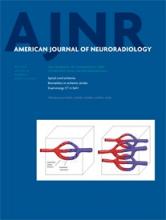Abstract
BACKGROUND AND PURPOSE: Patients with SAH are at increased risk of delayed infarction. Early detection and treatment of delayed infarction remain challenging. We assessed blood-brain barrier permeability, measured as permeability surface area product, by using CTP in patients with SAH with delayed infarction.
MATERIALS AND METHODS: We performed a retrospective study of patients with SAH with delayed infarction on follow-up NCCT. CTP was performed before the development of delayed infarction. CTP data were postprocessed into permeability surface area product, CBF, and MTT maps. Coregistration was performed to align the infarcted region on the follow-up NCCT with the corresponding location on the CTP maps obtained before infarction. Permeability surface area product, CBF, and MTT values were then obtained in the location of the subsequent infarction. The contralateral noninfarcted region was compared with the affected side in each patient. Wilcoxon signed rank tests were performed to determine statistical significance. Clinical data were collected at the time of CTP and at the time of follow-up NCCT.
RESULTS: Twenty-one patients with SAH were included in the study. There was a statistically significant increase in permeability surface area product in the regions of subsequent infarction compared with the contralateral control regions (P < .0001). However, CBF and MTT values were not significantly different in these 2 regions. Subsequent follow-up NCCT demonstrated new delayed infarction in all 21 patients, at which time 38% of patients had new focal neurologic deficits.
CONCLUSIONS: Our study reveals a statistically significant increase in permeability surface area product preceding delayed infarction in patients with SAH. Further investigation of early permeability changes in SAH may provide new insights into the prediction of delayed infarction.
ABBREVIATIONS:
- BBBP
- blood-brain barrier permeability
- DCI
- delayed cerebral ischemia
- PS
- permeability surface-area product
- © 2015 by American Journal of Neuroradiology
Indicates open access to non-subscribers at www.ajnr.org












